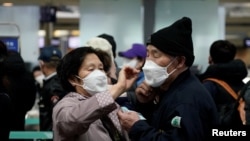Even though South Korea has drastically reduced its number of new coronavirus infections, public health officials and analysts are warning it is too soon to declare victory against what is likely to be a long-term pandemic.
For five out of six days this week, South Korea has reported fewer than 100 new infections. That is down significantly from a peak of 909 new cases February 29.
South Korea has fought the virus without resorting to widespread restrictions on movement or forced closure of businesses, as seen in other countries. Instead, it made coronavirus tests widely available, conducted data-driven investigations of infection paths and quickly isolated those exposed.
But the success is fragile, authorities warn, especially since dangerous cluster infections continue to emerge in settings like churches, offices and nursing homes.
“We cannot let our guards down yet," said Yoon Tae-ho, a senior health ministry official, at a regular briefing Friday. “We believe that we will still see a continued and prolonged coronavirus outbreak.”
Group infections
South Korea appears particularly susceptible to group infections, in part because nearly half the country lives in the densely populated Seoul metropolitan area.
Authorities say nearly 90 percent of South Korea's confirmed coronavirus cases have been related to cluster infections. The majority have been linked to a single “super cluster” that began at a gathering of a fringe religious group in the southeastern city of Daegu. Authorities have tested nearly 210,000 members of the group, known as the Shincheonji Church of Jesus.
But even though the Shincheonji-related infection appears to have been largely contained, that doesn't mean the wider threat is over, warned Ki Moran, who heads the Korean Society of Preventive Medicine’s committee for emergency response.
“It is still very dangerous right now,” said Ki, especially in enclosed public spaces like offices, churches, hospitals, coin karaoke rooms, or computer gaming centers. She said the situation will have stabilized only when cluster infections have been eliminated and the main source of infection is individual transfer.
Social distancing fatigue
“The longer it lasts, the more social fatigue there will be,” she said. “And as a result, the participation rate will fall.”
Most of the South Korean outbreak has been contained to the southeastern part of the country. In Seoul, the situation has never felt out of control, even as the number of cases continues to slowly but steadily grow. In many ways, life in the capital continues as normal, though schools, sporting events, and most other group gatherings have been canceled.
Though many South Korean religious groups have moved their services online, the Seoul city government estimates that about one-third of Protestant churches in the capital held in-person services on Sunday, according to the Yonhap news agency.
Authorities have so far asked, but not required, churches to close their doors temporarily. On Friday, Yoon, the public health official, encouraged all religious gatherings to be canceled.
“The weather is getting nice and many people are having a tough time having to stay at home,” Yoon said. “But just as you have been participating in social distancing measures up until now, we hope these measures could be prolonged moving forward.”
Worldwide cases spike
In total, South Korea has reported 8,652 infections. Ninety-four people have died, mostly elderly patients with underlying conditions.
South Korea has now been surpassed by several other countries, including the United States, in the number of overall infections, raising the risk of imported cases from overseas.
South Korean authorities, who have so far detected 17 imported virus cases, have tightened immigration procedures.
Beginning Sunday, all arrivals from Europe will be required to get a coronavirus test. Those who test positive will go to a hospital or residential treatment center. Even those who test negative must go into self-isolation for two weeks.
South Korean authorities say such measures could also soon apply to those coming from the United States and other Asian countries.
In the coming weeks, tens of thousands of college students from mainland China, where the virus originated, had been expected to return to South Korea, though some may delay those plans since most classes remain postponed.
“As the virus spreads globally, that could lead to more deaths here,” said Kang Da-yean, a nurse working at a makeshift quarantine facility on a college campus in the worst-hit city of Daegu.
Though Daegu officials have stated they hope to defeat the virus by the end of March, Kang is skeptical that it can happen. And she cautioned against anyone tempted to let their guard down.
“This will speed up the spread of the virus,” she said. “It is deadly serious for elders and those with underlying conditions. And there is no cure yet. It is just too soon to say the situation has been controlled.”
Lee Juhyun contributed to this report.




